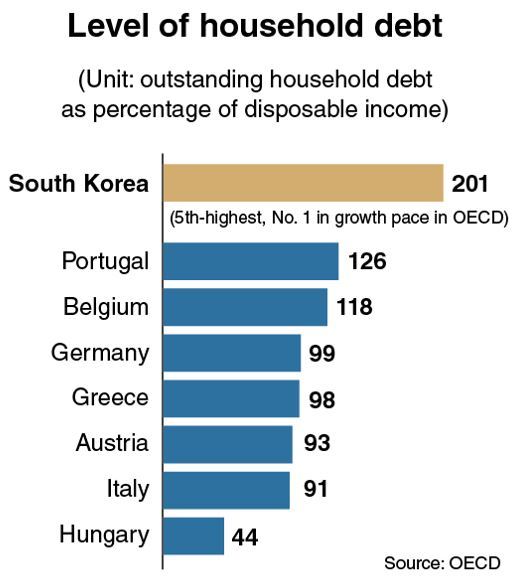 |
The logo of the Organization for Economic Cooperation and Development, headquartered in Paris (OECD) |
SEJONG -- South Korea has become one of the several countries among the Organization for Economic Cooperation and Development’s 38 members to see household debt exceed more than double its disposable income.
Further, Korea was the fastest member in terms of growth of outstanding household debt in 2020, recent data showed, as well as the fastest for the 2016-2020 period.
According to the Paris-based organization, Korea’s outstanding household debt was equal to 201 percent of net household disposal income as of last year. This placed the nation fifth out of the 19 members that have publicized their 2020 figures.
 |
(Graphic by Kim Sun-young/The Korea Herald) |
Korea, which posted 175 percent in the household debt-to-disposal income ratio in 2016, overtook Canada and Sweden in the ranking in recent years.
Its figure compares to 145 percent in the UK, 126 percent in Portugal and 118 percent in Belgium. Among members with figures less than 100 percent were Germany (99 percent), Greece (98 percent) in Greece, Austria (93 percent) and Italy (91 percent).
Some countries in Eastern Europe recorded under 80 percent -- 77 percent in the Czech Republic, 59 percent in Poland and 44 percent in Hungary.
Based on 2019 or 2018 figures, the US (105 percent as of 2019), Japan (114 percent as of 2018), France, Spain and New Zealand are likely to post lower 2020 figures than Korea.
A worrisome point is that Korea saw the figure surge by 13 percentage points from 188 percent in 2019 to 201 percent in 2020. This marked the highest growth among figures held by the OECD members.
In contrast, Canada saw its figure fall 11 percentage points from 186 percent to 175 percent over the corresponding period. Switzerland, the Netherlands and Poland also saw their debt burdens shrink.
Most of the 19 members recorded annual growth of less than 5 percentage points.
For a wider period -- from 2016 to 2020 -- Korea saw its figure climb 26 percentage points, from 175 percent in 2016.
Korea overtook Finland, which had the fastest growth in the OECD in late 2010s. The ratio of household debt-to-disposable income in Finland grew 23 percentage points during the 2016-2020 period.
Many online commenters and analysts in Korea share the view that real estate policy failures have led to mounting consumer debt, which has reached an all-time high of 1,805 trillion won ($1.5 trillion).
The Moon Jae-in administration has implemented a variety of anti-speculation regulations in the real estate sector, such as levying heavier capital gains taxes on apartment sales.
Nonetheless, apartment prices in Seoul and some major regions in Korea continued to renew record-highs. This has brought the situation that more people, including young people in their 20s and early 30s, have joined the move to buy apartments by taking out mortgages and credit-based loans.
The fever of buying homes has been aggravated in 2020 amid young people’s willingness to take risks and fear they might never be able to buy an apartment as prices continue to soar.
Low interest rates set by the Bank of Korea have also fanned borrowing. During Moon’s term since May 2017, the nation’s benchmark rate has ranged between 0.5 percent and 1.75 percent per annum. It remained at an all-time low of 0.5 percent from May 2020 to July 2021.
Though the central bank conducted a rate hike to 0.75 percent in August 2021, the level is still low compared to a decade ago in October 2011, when the rate was 3.25 percent.
By Kim Yon-se (
kys@heraldcorp.com)









